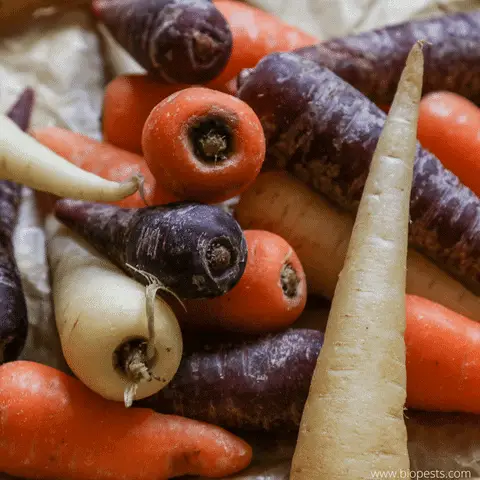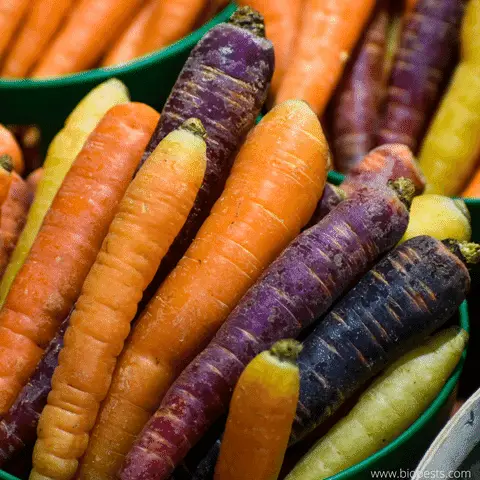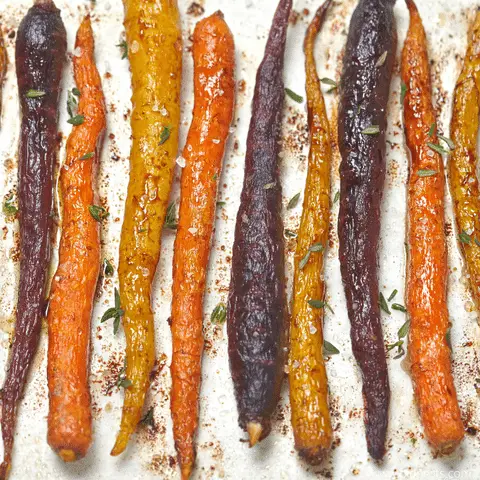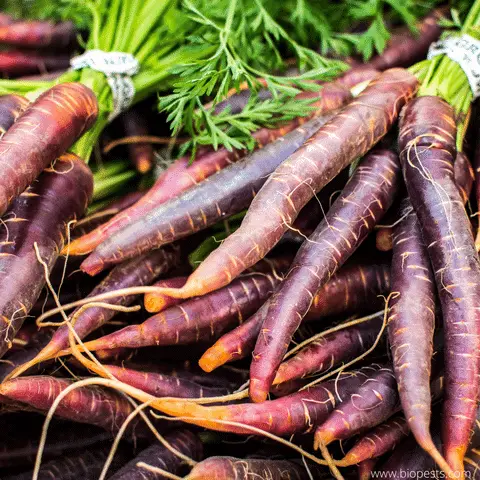If you shop for carrots in a supermarket, you will probably only see the traditional orange carrots on the shelves. Extending your shopping locations to include farmer’s markets, you may see carrots of various colors. If you see blue carrots for sale, will they be edible or poisonous?
Blue carrots are not poisonous but are a variety of purple-colored carrots from heirloom strains. The carrots are not toxic and can be eaten at any stage of growth, whether as baby carrots or fully matured vegetables. Other carrot colors are white, yellow, red, and orange.
Blue carrots may seem to be a novelty, and the color may deepen to a purple color, but are these carrots edible? People are naturally cautious about colors in vegetables that they have never seen before since it could indicate toxicity. We will discuss blue carrots to determine whether they are poisonous.

Are Blue Carrots Toxic?
Most people are not familiar with seeing vegetables in unusual colors, and it causes them to be cautious about what the color means for the plant’s edibility.
Many plants are toxic at certain stages of their life cycle, indicated by the color, and as the plant matures and becomes edible, the color changes.
This is why we do not eat green potatoes; potatoes with a green tinge on the skin can be toxic if eaten in large quantities. Does this principle hold true for carrots of different colors; are blue carrots poisonous?
Carrots come in a wider range of colors than you typically see on your supermarket or grocery store shelves. Carrots can be white, yellow, orange, red, or purple in color, which I am sure leaves you questioning where blue carrots fit in.
Blue carrots are not technically blue carrots but rather shades of purple. Purple carrots come in a variety of shades, from light purple to almost black. The carrots that most people call “blue” are in the purple spectrum or carrots.
Blue carrots are not poisonous and will do you no harm if you eat them. Different color carrots bring a colorful variety to the food on a plate, and that is often why these cultivars are grown.
In the early history of carrots, most varieties were yellow, white, or purple, and the now common orange carrot was an unusual sight. The public color preference has been reversed, where orange carrots are what we expect to see in carrots.
What Causes The Carrots To Be Blue
As we have mentioned, blue carrots are not technically blue carrots but are classed as purple carrots. The color comes from the genetic cultivar, which has genes that predispose carrots to develop an unusual color.
Blue-colored carrots are not an indication that the carrots are poisonous or unsuitable for eating. You can safely surprise your family with blue carrots on their plate to bring some visual variety to your normal food.
The different color in blue carrots and other differently colored carrots is not a genetic modification, so you need not be concerned that you are eating a genetic mutation that could be potentially harmful.
Is It Easy To Grow Blue Carrots?
Blue or purple carrots are usually only available to home vegetable gardeners as heirloom seeds, which is a good thing.
Heirloom seeds are not genetically modified, which means that the seeds have a completely natural history without human intervention at the genetic level to manipulate the carrot’s characteristics.
Blue carrots are as easy to grow as any other carrot color and have the same growing condition requirements.
- Well-drained soil. Carrots need a well-draining growing medium to prevent root rot.
- Loose soil. Carrots do not like compact soils, as this does not allow the carrot root to expand as it grows.
- Good moisture retention. While carrots need well-drained soil, they also need soil that retains moisture to prevent the root from drying out.
- Plenty of sunshine. Carrots need between 6 to 10 hours of sunshine daily to grow well.
- Cooler temperatures. High mid-summer temperatures stunt the growth of carrots, making the best time to plant in early spring or late summer.
- Do not overwater carrots. Carrots need 1-inch of water once a week. Overwatering can result in root rot.
- Fertilize 6 weeks after sowing. Fertilize your carrots six weeks after sowing with a low-nitrogen fertilizer to promote good root development.

These growing conditions apply to growing blue or purple carrots as well. You will find that different shades of purple carrots will have different times from seed to harvest, from as little as 58 days in the Cosmic Purple variety to as much as 130 days in the slow-growing Gniff purple-skinned variety.
Are Blue Carrots Good For Eating?
As with other vegetables, certain cultivars are grown specifically for certain characteristics, determining the best way to use the carrots.
Purple carrots may appear blue in some shades and are also grown for specific culinary purposes. Some blue and purple carrots are only dark on the outside but have different colors on the inside.
These multi-colored carrots make a striking visual impact when used in a fresh salad. The Cosmic Purple carrot has purple skin but is a yellowish-orange on the inside.
Other great salad varieties are the Purplesnax, which has a purple outer color and a light orange core, and the Purple 68, which also has a purple outer but a white central core.
The Purplesnax variety is very popular in salads due to its significantly sweeter taste compared to the other varieties.
The Gniff carrot has purple skin with a white inner core and is preferred as it is great for long-term storage and works great as a pickling carrot.
These purple and blue carrots can be used fresh in a salad, chopped and cooked in your favorite dish, or eaten raw straight out of the garden.

Blue carrots do not lose their color when cooked, so your boiled or roasted blue carrots will look as striking in a hot dish as they do raw.
What Do Blue Carrots Taste Like?
Your tastebuds may be a little disappointed if you expect a dramatic change in the flavor of differently colored carrots. While there is a slight flavor difference, it is not as dramatic as the change in color.
Purple and blue colored carrots are typically sweeter than most other color variations. The intensely dark varieties and the carrots that are purple all the way through also have a slightly spicy, peppery flavor to them. The purple carrots with different colored cores do not display this peppery flavor.
The traditional carrot flavor is still present in the purple carrots but to varying degrees of intensity based on the different shades of purple.
Are Blue Carrots Nutritious?
The color variation does not change the nutritional value of the carrots, meaning the blue carrots will have the same nutritional value in your diet as the common orange-colored carrots.
A half cup of carrots in your daily diet will give you a good source of vitamins K, A, and C, as well as potassium, fiber, calcium, and iron.
Carrots’ high levels of carotenoid and anthocyanin antioxidants make them useful cancer-fighting food and good heart health. The potassium in carrots is good for controlling blood pressure, and the high fiber content benefits weight management and helps to keep your bathroom visits regular!
The vitamin C in carrots contributes to building a healthy immune system, which benefits your overall health, while the vitamin A and beta-carotene levels can lower your risk of diabetes.
The calcium and vitamin K in carrots are important for bone development, making carrots an important food for pregnant moms and older people.
Where Can You Get Blue Carrot Seed?
Several seed procurement options are open to you if you want to experiment with growing carrots of different colors. You can buy seed packets that produce a single carrot color or a rainbow pack that gives a good cross-section of colors. You also have the choice of hybrid or heirloom varieties.
Your local garden center is a good place to start your seed search for colorful carrots. You will most likely find the different color carrot seed packets in the heirloom seed section.
Selecting a rainbow pack is a good option because it will give you the opportunity to grow and taste carrots of different colors. You can then decide which carrot color you prefer the most and then purchase a full packet of the desired color variation.
Some of the vendor’s places where you can source these carrot seed packs include Amazon, Organo Republic and Mary’s Heirloom Seeds.
These resources sell not only the rainbow carrot seed packs but also the single-color seed packets, which allow you to plant an entire crop of one particular carrot color.
Conclusion
Blue carrots may look unusual, but they are certainly not poisonous and can be eaten. The different color varieties in carrots offer a new visual appeal to the food on the plate, and some blue or purple varieties offer enhanced sweetness.
Why not grow some of your own multi-colored carrots in your vegetable garden? It could be a good way to entice your kids to eat their veggies!
Some of the links above are affiliate links, meaning, at no additional cost to you, I will earn a commission if you click through and make a purchase.
Wanna know more about carrots and carrot pests? These articles may interest you:
Why Do My Carrots Have Holes In Them?
Are Hairy Carrots Safe To Eat?

